
Pew report
An interesting initiative from Stanford University Press to enable scholars to publish and peer-review the interactive content they have produced.
"The press was the first academic publishing group to offer scholars a way to publish and peer review academic research that involves digital tools not usually found in online journals. The idea for the program, launched last year with the help of a $1.2 million grant from the Andrew W. Mellon Foundation, came out of press director Alan Harvey’s desire to “break the box of publishing."As is well known, the university press marketplace is very challenged with revenues down or (at best) flat for most but the largest presses and the increasing challenges on campus to justify their existence. Like Stanford, other presses are seeking to encourage innovation in their publishing programs and looking to new market opportunities. As the press report notes, this effort at Stanford builds on their core expertise but nevertheless required new methods established 'from scratch'. That requires fortitude and assumes some risk but is the type of effort required to move legacy models to new market opportunities.
Article Link
Elsevier proposed last week a regional access model for open access as quoted in the Time Educational Supplement,
Gemma Hersh, Elsevier’s vice-president for policy and communications, says that universities and publishers “need to think creatively about how open access can be made to work in practice on a regional scale to cater to different paces and approaches to open access in different parts of the world”.It seems this idea hasn't really been thought through and indeed the raised opposition not least because academic research is increasingly global in nature thus making access models on a regional basis a little problematic. Here from Toby Green (@tobyABGreen) on Medium:
“In this way [of regional approaches], Europe could move forward to achieve its goals without waiting for international consensus,” Ms Hersh said. “And if this approach could be shown to deliver benefits to Europe, then it would create a persuasive evidence base from which to encourage other regions to follow Europe’s lead.
“At the same time, such a regional approach would have the advantage of enabling different parts of the world to move at their own pace and in line with their own needs.”
Your suggestion that a regional approach to gold open access might be a way forward pains me as much as Lucky’s soliloquy does the protagonists in the play. If there is one industry that is truly global in nature, it is scholarly publishing. This won’t be news to you, but if scientific articles are increasingly co-authored on an international basis and these papers tend to be more highly cited, then surely it is a nonsense that an article could be open in Europe but closed in Australia. A regional approach would also prolong inequality between the haves and haves not, which must be unacceptable at a time when digital has opened the way to bridging divides at almost no cost.